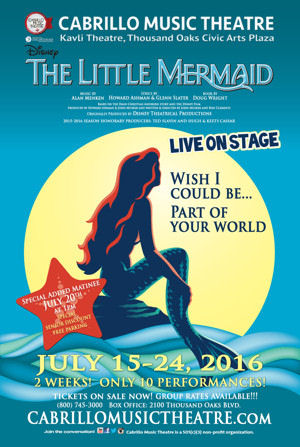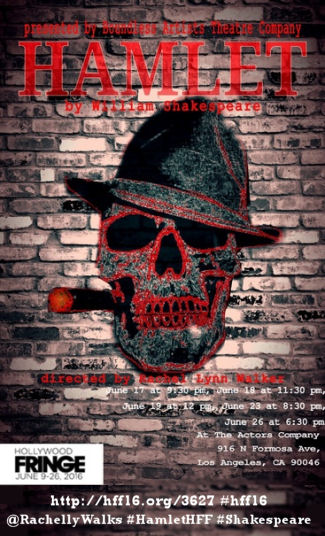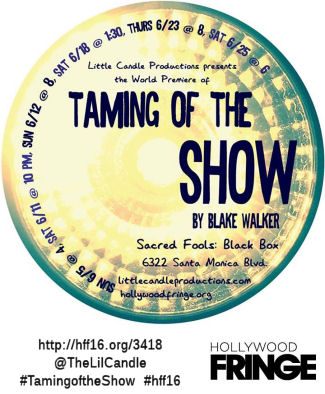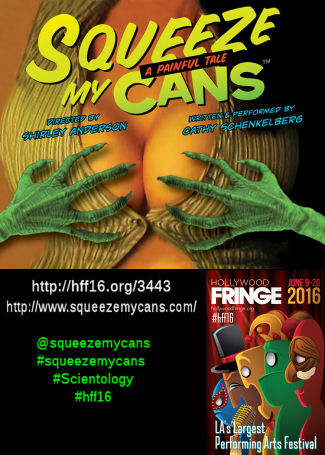
 This season at Cabrillo Music Theatre (FB) has been a great one. All four of the season’s show have been “firsts” for me — in that the Cabrillo production has been the first time I have seen the adult version of the show done by a professional company. Their first show, Damn Yankees, I’d only seen Van Nuys HS do. Their second show, A Funny Thing Happened … Forum I had only seen the movie version. Their third show, Children of Eden, I’d only seen a church group do. Last night’s show, Disney’s The Little Mermaid, I’d only seen the Jr. version from Nobel Middle School.
This season at Cabrillo Music Theatre (FB) has been a great one. All four of the season’s show have been “firsts” for me — in that the Cabrillo production has been the first time I have seen the adult version of the show done by a professional company. Their first show, Damn Yankees, I’d only seen Van Nuys HS do. Their second show, A Funny Thing Happened … Forum I had only seen the movie version. Their third show, Children of Eden, I’d only seen a church group do. Last night’s show, Disney’s The Little Mermaid, I’d only seen the Jr. version from Nobel Middle School.
In lacking the ability to see a professional version of these shows, I wasn’t alone. Damn Yankees is rarely done on the large stage, and Funny Thing is so complex you don’t often see it (although it had a recent 99-seat revival at Crown City). Children of Eden has never been on the big stage in LA. All three of those are older musicals, so perhaps that’s not a surprise.
But The Little Mermaid? After it closed on Broadway in 2009 after a mixed run on 685 performances and tepid reviews, a tour was announced but never materialized. Unlike other Disney musicals — Beauty and the Beast, The Lion King and Newsies have played the Hollywood Pantages (FB) multiple times; Aida has been at the Ahmanson Theatre (FB) — The Little Mermaid has never been on a main Los Angeles stage. Even the recent Hollywood Bowl production was actors singing along to the animated film, not the musical. The only place to see it has been school productions… until this year.
After the tepid reception of the show on Broadway, professional productions were limited… until Glenn Casale came along. Glenn reworked and redesigned the production from the problematic Broadway version for a 2012 Dutch production. He then reworked it again for Sacramento in the round later that year. It hit the Paper Mill Playhouse in 2013, and then the Pittsburgh CLO (remember those names, you’ll see them later). This year, a mini-tour of the revised version materialized, hitting cities such as Houston’s Theatre under the Stars, Sacramento, Dallas, and La Mirada. That would have been an interesting version to see, as it had both Tracy Lore (of CMT’s Once Upon a Mattress) and Devon Hadsell (FB) (of Chance’s Lysistrata Jones) in it. But that wasn’t Cabrillo’s version.
Cabrillo Music Theatre is Broadway in Your Backyard, and they pride themselves in not booking tours. They cast using a mix of local and new-to-local top talent. They pride themselves on finding newcomers (such as Katharine McPhee (FB), who was in CMT’s Annie Get Your Gun) who excel. They do this all in an environment of community outreach and giving back. They had an existential scare earlier this year, but they survived and are going strong into next year.
This is a long way of saying that last night we were at CMT’s second performance of Disney’s The Little Mermaid, and it was our first time seeing the show in a fully professional version. It was our first time seeing the reworked Glenn Casale envisioning, reworked and reimagined just a little bit more by director Larry Raben (FB) and choreographer Heather Castillo (FB). I should note that I also came into the show with no preconceived notions from the original animated movie as — and you’re probably shocked — I’ve never watched the entire animated version. I’m also pleased to say (BLUF as it were), that we were blown away by the imagination and inventiveness of the CMT version, and it continued their standard of theatrical excellence for which they are known.
You, on the other hand… you have likely seen the 1989 animated film, based on the Hans Christian Andersen story, and produced by Howard Ashman and John Musker, written and directed by John Musker and Ron Clements, with music and lyrics by Alan Menkin and Howard Ashman. You may have even heard (as had I) the score of the stage version, which had added songs by Howard Ashman and Glenn Slater and book by Doug Wright. So you probably know the story well.
So…. I’m not going to detail it for you. However, I will note that there have been significant changes from the animated movie, especially in Ariel’s motivation, and significant changes from the 2009 Original Broadway version, especially in the nature of the relationship between Triton and Ariel, and even more pointedly between Triton and Ursula. They are detailed somewhat in the Wikipedia synopsis of the stage version, and even more so in the summary of how Glenn Casale reworked the stage version in 2012. However, do be warned: this is, at its heart, a children’s fairy tale. Don’t expect depth, angst, bathos, or truly adult themes. This isn’t The Lion King, and it’s not based on Hamlet. It is based on a Disney animated movie. It improves on it some, but can only go so far.
Cabrillo’s version of the show brought the undersea world to life in a creative and imaginative way. This is not to say that feet were never visible on the fish — during some of the dance numbers they were wearing colorful sneakers. But rather, for the main mer-folk, their costumes covered the feet; this was combined with flying affects to allow them to swim across the stage as if they had fins. Other characters glided across the stage on hoverboards or skate-shoes. There were giant puppets of jellyfish. There was undulating seaweed. There was loads of black lighting and iridescence. This contrasted with the human world, which was sunlit in a normal spectrum, with normal costumes.
The performances, as with all Cabrillo productions, were excellent. In the lead position was Alison Bagli (FB) as Ariel. Bagli brought a wonderful youthful enthusiasm and a lovely voice to what could be a saccharine role. In particular, she made the role seem, well, as realistic as a mermaid could be — both in capturing the late teenage rebellion against the strictures of a parent refusing to see the child as an adult, and in capturing the joy of discovering something new…. like feet. But she was somehow more… adult. She didn’t play the role as the typical 14-year old; she was 19 with glimpses of 15. She did a spectacular job with signature numbers such as “The World Above” and “Part of Your World”.
In the featured role as the crab mentor, crab advisor, and composer was Lawrence Cummingsæ (FB) as Sebastian. Cummings was an accomplished singer and dancer, doing wonderful in Sebastian’s key songs of “Kiss the Girl” and the ear-worm “Under the Sea”. He was able to capture the exasperated nature of the character well, and provided wonderful comic relief. [æ denotes members of Actors Equity]
Featured actors with a more understandable relationship to Ariel were Conor Guzmánæ (FB) as Ariel’s love interest, Prince Eric, and David Engelæ (FB) as Ariel’s father, King Triton. Guzman’s Eric was the typical Disney prince, whom the story imbued with a problem similar to Ariel’s: having a nature different from what their parent wanted them to be. He captured that aspect well, and had a wonderful singing voice to boot. He also exhibited a great chemistry with Bagli’s Ariel, especially in numbers like “One Step Closer”. Engel’s Triton was suitably parental, although his kingly presence was a bit light until supported by sound effects and bass vibrations. He had a wonderful number in “If Only”, especially in the second act’s quartet, but was lightly used by the story.
In featured roles as Ariel’s friends were Pablo Rossil (FB) as Scuttle, the seagull, and Michael C. Kennedy (FB) as Flounder, the tropical fish. Kennedy’s Flounder, who we meet first, does a great job of capturing a boy with teen affection for Ariel, who never seems to quite notice him. He’s one of the three actors who use hoverboards heavily in the show, and he handles it quite well. He brought a great youthful enthusiasm to the role. Rossil’s Scuttle is much more comic relief, although he does get a great number in “Positoovity”. He does a reasonable job of making the character his own, as opposed to channeling the animated version’s Buddy Hackett. As one would expect, he does a lot of flying in the role, which he handles quite well.
The requisite evil side of the story was represented by Triton’s sister, the octopus Ursula (Debbie Prutsman) in the main position, and electric-eels Flotsam and Jetsam (Eric Stanton Betts (FB) and Alex Levy/FB, respectively) as the supporting minions. Prutsman was strong as Ursula, capturing the evil nature of the character well, especially in songs like “Daddy’s Little Angel” and her signature number, “Poor Unfortunate Soul”. Flotsam and Jetsam were more supporting eels, although they did get a little bit of a number in “Sweet Child”, and handled their hoverboards well.
Rounding out the named characters were David Gilchrist (FB) as Grimsby, Tyler Stouffer (FB) as Chef Louis, and the gaggle of girls that made up Ariel’s sisters: Gillian Bozajian (FB) (Atina), Lyrissa Leininger (FB) (Adella), Janaya Mahealani Jones/FB (Arista), Missy Marion (FB) (Andrina), Jamie Mills (Aquata), and Annie Sherman (FB) (Allana). Gilchrist was great as always in a comic supporting role; we’ve seen him in a number of productions over the years. Stouffer really only gets one number –“Les Poissons” — which really has little to do with the plot other than comic relief. He handled the number well, although it was difficult at times to make out his words (which could have been a sound problem). Ariel’s sisters had fun with their few numbers — “Daughters of Triton” and particularly “She’s in Love” — but were otherwise not deeply characterized in the story. It was nice to see a bit of diverse casting there.
Rounding out the production was one of the few luxuries that CMT has: a large ensemble and a large kids ensemble, which they used to great effect (especially the kids in quite a few numbers). The ensemble consisted of: Jeni Baker (FB), John Paul Batista (FB), Alex Choate (FB), Rodd Farhadi (FB), Kevin Gilmond (FB), Scott Hendrickson (FB), Jenny Hoffman (FB), Kurt Kemper (FB), Julia Kreinces (FB), Joey Langford (FB), Janelle Loren (FB), Kenneth Mosley (FB), Brittney Nevison (FB), Jordan Schneider/FB, and Ryan Schultze/FB. The kids ensemble consisted of Baylee Fogelmanis, Calista Loter, Mia Nelson, Drew Rosen, Marcello Silva/FB, Taylor Lynda Thomas/FB, and Hattie Ugoretz/FB. Kenneth Mosley (FB) was also the understudy for Sebastian.
As is pointed out at every CMT show: Live musical theatre needs live music. The CMT Orchestra, under the music direction of Colin Freeman (FB), was excellent. The orchestra consisted of: Colin Freeman (FB) (Conductor), Gary Rautenberg (FB) (Flute, Alto Flute, Piccolo, Clarinet); Kimaree Gilad (Oboe, English Horn); Darryl Tanikawa (FB) (Clarinet, Bass Clarinet, Soprano Sax, Alto Sax); Bill Barrett (Trumpet, Flugelhorn); Melissa Hendrickson (FB) (Horn); Sharon Cooper (Violin I – Concertmaster); Sally Berman (Violin 2); Rachel Coosaia (FB) (Cello); Cassie Nickols (FB) (Keyboard I); Lloyd Cooper (FB) (Keyboard II); Tom Griffin (Keyboard III); Colin Freeman (FB) (Keyboard IV); Shane Harry/FB (Electric and Double String Bass); Alan Peck (Set Drums); and Tyler Smith/FB (Percussion). Darryl Tanikawa (FB) was the Orchestra Contractor. The orchestra was produced by Tanikawa Artists Management LLC.
Turning to the remaining creative and production credits. The scenery design was by Kenneth Foy, with the scenery, props, and costumes having been created by a partnership with the aforementioned Paper Mill Playhouse (FB), Pittsburgh CLO (FB), Kansas City Starlight Theatre (FB), Theatre Under the Stars in Houston, and Dallas Summer Musicals (FB). Costume Design was by Amy Clark and Mark Koss. Christine Gibson (FB) was the costume supervisor. Stephanie Fenner/FB and Cassie Russek (FB) did the hair and makeup design, and Alex Choate (FB) designed additional props. I mention these all in virtually one breath because they all combined to create magic: an undersea delight, and believable and identifiable characters. The magic was additionally created by the flying effects of ZFX, Inc.; the sound design of Jonathan Burke (FB), and the lighting design of Christina L. Munich (FB). I’ll note there were a few times where the spots were a little off; this was the second performance, so presumably that will be corrected. Rounding out the production credits: John W. Calder III (FB) (Stage Manager); David Elzer/Demand PR (Press Representative); C. Raul Espinoza (FB) (Marketing Consultant); Jack Allaway (Technical Director). Cabrillo Music Theatre (FB) is under the artistic direction of Lewis Wilkenfeld (FB).
There is one more weekend for you to catch this excellent production of Disney’s The Little Mermaid, with shows from July 20 – 24, 2016. Tickets are available through Ticketmaster. Discount tickets may be available through Goldstar.
* * *
Ob. Disclaimer: I am not a trained theatre critic; I am, however, a regular theatre audience member. I’ve been attending live theatre and concerts in Los Angeles since 1972; I’ve been writing up my thoughts on theatre (and the shows I see) since 2004. I do not have theatre training (I’m a computer security specialist), but have learned a lot about theatre over my many years of attending theatre and talking to talented professionals. I pay for all my tickets unless otherwise noted. I am not compensated by anyone for doing these writeups in any way, shape, or form. I currently subscribe at Cabrillo Music Theatre (FB), the Hollywood Pantages (FB), Actors Co-op (FB), and I plan to renew my mini-subscription at the Valley Performing Arts Center (VPAC) (FB). Past subscriptions have included The Colony Theatre (FB) (which went dormant in 2016), and Repertory East Playhouse (“REP”) (FB) in Newhall (which entered radio silence in 2016). Through my theatre attendance I have made friends with cast, crew, and producers, but I do strive to not let those relationships color my writing (with one exception: when writing up children’s production, I focus on the positive — one gains nothing except bad karma by raking a child over the coals). I believe in telling you about the shows I see to help you form your opinion; it is up to you to determine the weight you give my writeups.
Upcoming Shows: The end of July gets busy, with Weird Al Yankovic at the Hollywood Bowl (FB) on July 23, Operaworks (FB) Opera Re-Constructed at CSUN on July 24, and a mid-week Hollywood Bowl (FB) concert of Wynton Marsalis and Aaron Copeland on July 28, and … currently nothing for the weekend. August is a bit more open in terms of theatre. The first weekend just has a Jethawks game on Sunday; the second weekend has a Bar Mitzvah. The third weekend brings another event from the wonderful counter-cultural orchestra, Muse/ique (FB) — American/Rhapsody — a celebration of George Gershwin. Late August sees us looking at shows down San Diego/Escondido for one weekend. The best of the shows available — or at least the most interesting — is Titanic from Moonlight Stages. September returns to conventional theatre. The first weekend has a HOLD for Calendar Girls at The Group Rep (FB). The second weekend may be another Muse/ique (FB) event — Summer/Time, a reimagined retelling of Porgy and Bess. The third weekend has a HOLD for Ma Rainey’s Black Bottom at the Mark Taper Forum (FB). The last weekend is The Hunchback of Notre Dame at The La Mirada Theatre for the Performing Arts (FB).
Continuing the look ahead: October is a bit more booked. The first weekend brings Dear World at the Valley Performing Arts Center (VPAC) (FB) and Our Town at Actors Co-op (FB), as well as the start of the High Holy Days. The second weekend has another Valley Performing Arts Center (VPAC) (FB) event: this time for Jazz at Lincoln Center Orchestra with Wynton Marsalis. The third weekend has yet another VPAC event: An Evening with Kelli O’Hara on Friday, as well as tickets for Evita at Cabrillo Music Theatre (FB) on Saturday. The following weekend brings Turn of the Screw at Actors Co-op (FB) on October 22 and the new Tumbleweed Festival (FB) on October 23. The last weekend of October brings Linden Waddell’s Hello Again, The Songs of Allen Sherman at Temple Ahavat Shalom (a joint fundraiser for MoTAS and Sisterhood). Oh, and if that wasn’t enough, October is also the North Hollywood Fringe Festival (FB), and it looks like a theatre in Pasadena will be presenting the musical Funny Girl. November is still in the planning stages, but we know it will include Hedwig and the Angry Inch at the Hollywood Pantages (FB); a Day Out With Thomas at Orange Empire Railway Museum (FB) [excuse me, “Southern California Railway Museum”]; the Nottingham Festival (FB); and possibly Little Women at the Chance Theatre (FB) in Anaheim. As always, I’m keeping my eyes open for interesting productions mentioned on sites such as Bitter-Lemons, and Musicals in LA, as well as productions I see on Goldstar, LA Stage Tix, Plays411 or that are sent to me by publicists or the venues themselves.



 In Jewish literature,
In Jewish literature,  This was a Fringe production, and in their program they note that they “hope to use this opportunity at the Hollywood Fringe Festival to expand our audiences and develop the piece further”. I spent some time this morning, as I researched and wrote this, thinking about that question. The question that keeps coming to mind is: Is the Anne we meet when the play opens the same Anne as at the end of the play, and how do we make that clear. The Anne of the original book resonated with people because of the combination of youthful naiveté, wisdom, and optimism. Did these few days shape that, or did they create or change something about Anne? Figuring out the way to address dramatic visualization of that transformation would appear to be the “development” that would be appropriate. The other characters in the piece are the catalysts for Anne’s growth — and like catalysts, enable the reaction while staying unchanged or minimally changed.
This was a Fringe production, and in their program they note that they “hope to use this opportunity at the Hollywood Fringe Festival to expand our audiences and develop the piece further”. I spent some time this morning, as I researched and wrote this, thinking about that question. The question that keeps coming to mind is: Is the Anne we meet when the play opens the same Anne as at the end of the play, and how do we make that clear. The Anne of the original book resonated with people because of the combination of youthful naiveté, wisdom, and optimism. Did these few days shape that, or did they create or change something about Anne? Figuring out the way to address dramatic visualization of that transformation would appear to be the “development” that would be appropriate. The other characters in the piece are the catalysts for Anne’s growth — and like catalysts, enable the reaction while staying unchanged or minimally changed.
 Sometimes, you see a show and wonder what was going through the instigator’s mind. What prompted Stephen Sondheim to see a musical in the story of Sweeney Todd? What led Kander and Ebb to see a musical in the story of the Scottsboro Boys? Why did Merrill and Styne see a musical in the story of Prettybelle? Why, oh why, was there a notion to musicalize “The Madwoman of Chaillot” as Dear World? Musicalize Carrie? What are you smoking?
Sometimes, you see a show and wonder what was going through the instigator’s mind. What prompted Stephen Sondheim to see a musical in the story of Sweeney Todd? What led Kander and Ebb to see a musical in the story of the Scottsboro Boys? Why did Merrill and Styne see a musical in the story of Prettybelle? Why, oh why, was there a notion to musicalize “The Madwoman of Chaillot” as Dear World? Musicalize Carrie? What are you smoking?
 And just like that, with the coming of July,
And just like that, with the coming of July, 


